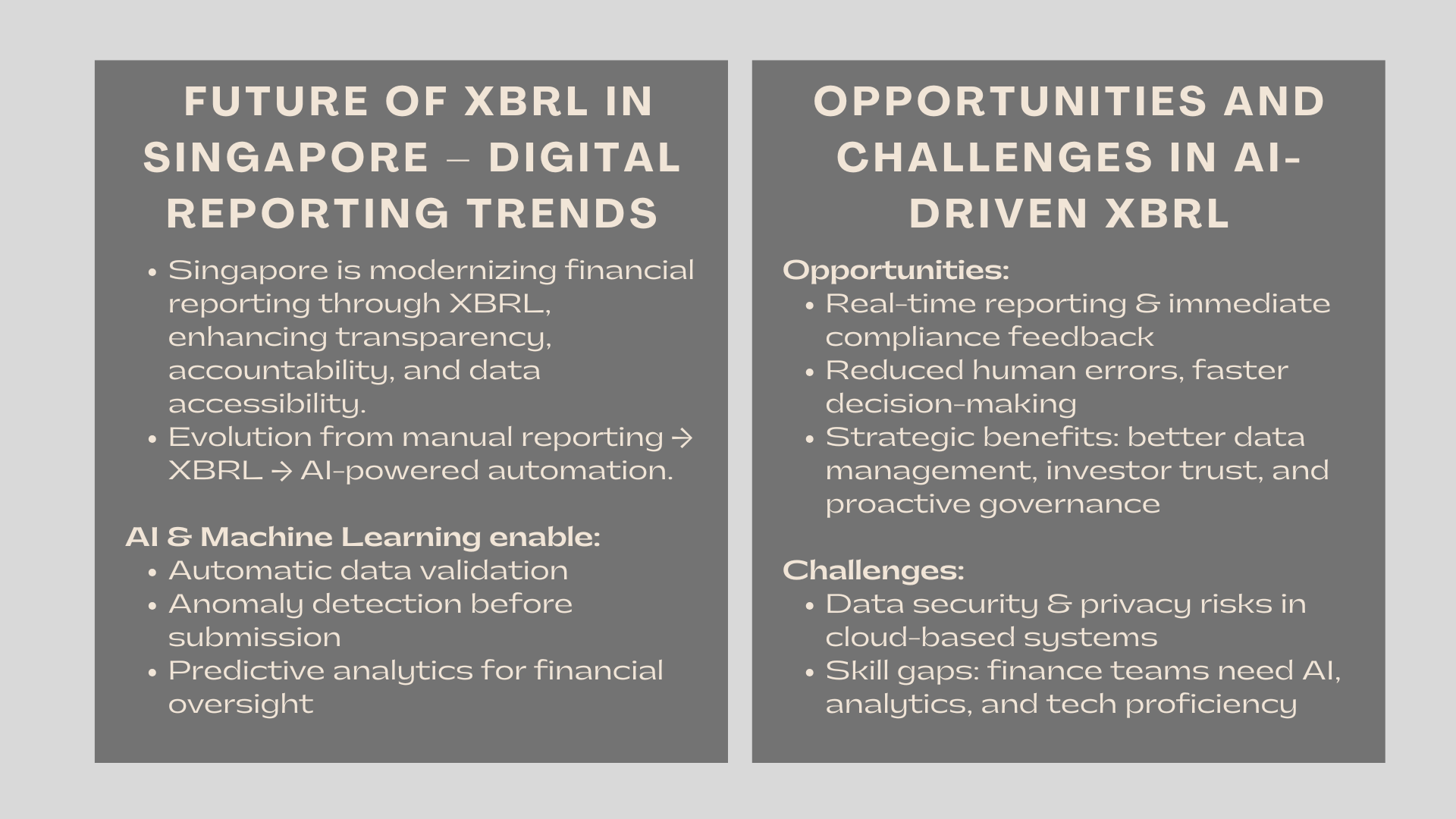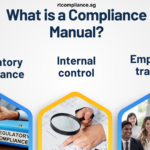Future of XBRL in Singapore – Digital Reporting and AI Trends
The financial reporting environment in Singapore is changing under the impetus of technology and modernization of the regulatory framework. Singapore, being amongst the most developed business capitals in Asia, has always been at the forefront of embracing the digital reporting norms which enhance transparency, accountability, and availability of corporate information. The use of eXtensible Business Reporting Language (XBRL) has already transformed the manner in which firms make and forward financial data to the Accounting and Corporate Regulatory Authority (ACRA).
Nonetheless, the process is not finished yet. The future of financial reporting is emerging with the rapid changes in automation, artificial intelligence (AI), and data analytics. The incorporation of the use of AI and more intelligent digital systems is redefining the speed, accuracy, as well as intelligence of XBRL processes. This paper discusses the technological changes that are defining the future of digital financial reporting as adopted by XBRL in Singapore and how artificial intelligence is affecting XBRL automation and compliance to businesses engaged in the progressive jurisdiction, especially in line with AI trends in Singapore.

1. XBRL Reporting in Singapore Evolution.
1.1 Manual Reporting to Digital Transformation.
Financial reporting was mainly manual, using PDFs or scanned statements before XBRL was made mandatory in Singapore; this did not allow the usage of data fully. The implementation of XBRL by ACRA was a move that was to make the digitization a reality. It enabled the financial data to be standardized, tagged and analyzed effectively.
With time, ACRA came up with improvements like the Bizfinx filing and improved versions of taxonomy that are easier to use and more accurate. Such developments did not only make it easy to comply but also enabled the regulators to examine data across the industries fast.
1.2 A World Trend toward Transparency.
The XBRL project in Singapore is consistent with international best practice used by financial authorities in Europe, United States and Australia. These jurisdictions are also shifting to machine-readable reporting standards that are well structured and can aid in the intermediate of cross-border information exchange and the sharing of regulatory needs by them.
Singapore can be singled out as a nation with a tendency to constantly modernize its digital infrastructure so that XBRL would not be outdated in the age of automation and data analytics powered by artificial intelligence.
2. Current Trends that are building the future of XBRL.
2.1 The Artificial Intelligence and Machine Learning are going to be integrated.
The method of data preparation, validation, and analysis of the financial data is being reinvented by artificial intelligence. With the help of AI algorithms, companies can automatically identify inconsistencies and classify financial items as well as validate data against the taxonomy of ACRA on-the-fly.
Such automation significantly decreases human mistakes and provides the procedures of submissions. The impact of artificial intelligence on XBRL automation and compliance is especially evident in how businesses can now detect anomalies or irregularities before submission—saving both time and potential penalties.
2.2 Predictive Analytics for Financial Oversight
The AI-powered systems can not only stop at data validation. They are able to predict financial trends, determine the possibilities of compliance risks, and give suggestions on any anomalies that may occur in the performance of the company. These tools enable the auditors and finance teams to shift toward responding to compliance to proactive financial governance.
By way of illustration, predictive analytics tools may be used to examine the data trends in a year-on-year basis to warn companies about uncharacteristic data trends in expenses or revenues that might raise an alarm by the regulators.
2.3 Blockchain and Data Integrity
Another trend shaping the future trends in digital financial reporting with XBRL in Singapore is the potential use of blockchain technology. By storing XBRL-tagged data on immutable ledgers, blockchain can enhance transparency and trust between regulators, companies, and investors.
XBRL submissions supported by blockchains can eventually provide almost immediate validation of financial data, reducing the risk of fraud and enhancing the quality of audits.
3. The advantages of AI and Automation in XBRL Filing.
3.1. Accuracy and efficiency are improved.
Reporting solutions based on AI are capable of processing thousands of data points within a few seconds, which is why the financial statements and the tagged aspects thereof have to be consistent. This minimizes the possibility of incompatible tags, omissions of disclosures or errors in calculations- problems that are typical when entering records manually.
Moreover, automation gets rid of redundant job tasks like tagging items on the line or balancing the scores. This would mean a great deal of time and money saved in both SMEs and large corporations.
3.3 Improved Monitoring of Compliance.
These innovations can also be used by regulators such as ACRA. Non-conforming submissions, red flags, and inconsistencies in financial reports can be detected very fast with automated systems. This makes the review process more efficient in that it gives the regulators time to look into other cases which are at high risk as opposed to routine checks.
In the case of companies, the possibility of pre-screening their submissions through AI tools and then submitting it means that the company is at ease before the submission there is little likelihood of rejection or penalties.
3.3 Integration with Accounting Systems made leaner.
The current cloud accounting programs are becoming more XBRL-compatible with modules that are readily compatible with the ACRA filing platforms. These systems can map the chart-of-account items to the corresponding XBRL taxonomy tags automatically, with the help of AI, and save on preparation time.
This degree of integration is such that companies, particularly the SMEs, with limited resources are able to keep their compliance even without the advanced levels of technical expertise.
4. Issues and Problems in the New Reporting Landscape.
4.1 Data Security and Privacy
Although the automation and AI are effective and efficient, they are creating cybersecurity threats. Organizations need to be certain that electronic data on financial information kept in the digital system is not accessed by unauthorized individuals, particularly in cloud-based XBRL filing systems.
Other authorities such as ACRA are likely to introduce more stringent data protection guidelines and demand companies to exhibit sufficient cybersecurity in their reporting practices.
4.2 Skill Deficiencies and Technology Preparedness.
The transformation towards the AI-driven financial reporting requires new competencies. Finance professionals and accountants will have to learn how to be skilled in data analytics interpretation, automated system management, and guarantee that the results produced by AI conform to accounting protocols.
The capacity-building and training will hence become necessary and especially to the SMEs that do not have specialized teams in technology.
4.3 Transition Costs
Although the efficiency in the long term is substantial, the initial cost of AI-based tools and modernized accounting infrastructure may be substantial. As the compliance requirements get complicated, businesses will need to weigh the short-term expenditure and the long-term worth of automation.
5. The Government and the Regulators.
5.1 A promise of digital transformation at ACRA.
ACRA is still at the forefront of helping Singapore to make its financial reporting smarter. The BizFinx system is likely to be improved with more validation tools, integration with the cloud, and, possibly, AI-powered compliance monitoring in the future.
Through its implementation of businesses early automation, ACRA is able to make sure Singapore is not left behind in the digital economy of the world and the standards of its regulatory compliance remain at the highest level.
5.2 Collaborative Innovative Ecosystem.
Software providers, government bodies, and professional accounting bodies are collaborating to create an ecosystem, which will facilitate digital transformation. The adoption of digital initiatives like grants and collaboration with fintech providers are making it possible to upgrade the systems of smaller companies without using excessive funds.
This kind of co-operation will make XBRL reporting innovation inclusive to large corporations, as well as new start-ups.
Prospects: The AI Era of Financial Reporting.
It is probable that the XBRL framework in Singapore will turn into a complete, AI-enabled ecosystem in the next few years. The automatic creation of reports, the application of AI in benchmarking, and immediate compliance feedback can become part of the accounting processes of businesses.
Furthermore, AI, blockchain, and cloud computing might result in the possibility of real-time financial reporting where all the information about the financial state is verified immediately and available to regulators and other interested parties. The transformation will re-establish corporate transparency and efficiency in the industries.
Conclusion to Future of XBRL in Singapore Digital Reporting and AI Trends
The future of the financial reporting in Singapore is clearly digital. As XBRL, automation, and AI continue to develop, businesses will have faster, more reliable, and transparent financial compliance procedures. The technological progress of Singapore makes it effective and competitive in the regulatory environment throughout the world.
Companies can prevent not only falling into compliance traps by adopting the future of digital financial reporting using XBRL in Singapore, but also will attain strategic benefits of data management, decision-making, and investor trust.
With AI and the growing digital reporting technology, the XBRL ecosystem in Singapore will serve as an example to the rest of the world- to show how innovation and regulation can work in harmony to create a more intelligent and responsible future in the financial industry.




